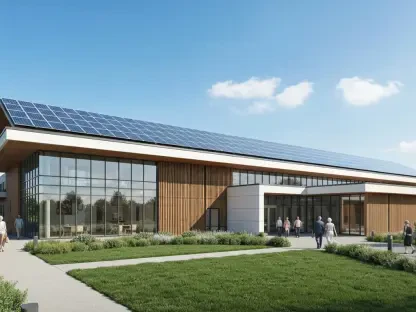What if thousands of new homes could emerge from an unexpected source in a city desperate for solutions to a crippling housing shortage? In London, a staggering 26,000 student bedrooms have been approved since 2025, offering a surprising lifeline to a metropolis where housing permissions for traditional homes have hit a decade-low. This surge in purpose-built student accommodation (PBSA) isn’t just about dorms—it’s a potential game-changer for addressing broader housing needs. As the capital grapples with skyrocketing rents and a growing student population, this development sparks curiosity about how student housing might reshape London’s future.
The significance of this trend cannot be overstated. With the private rental market under immense strain, PBSA approvals are not only meeting the demand for student living spaces but also easing pressure on other sectors of housing. Equivalent to over 10,500 traditional homes under the Greater London Authority’s methodology, these projects represent a beacon of hope in a landscape of stalled conventional developments. This story dives into how student housing is becoming a critical piece of the puzzle in tackling London’s housing crisis, revealing the strategies, impacts, and expert insights driving this momentum.
Why Student Housing Is Transforming London’s Landscape
At the heart of London’s housing struggle lies an unexpected ally: student accommodation. Since 2025, approvals for over 26,000 student bedrooms have marked a dramatic shift, positioning PBSA as a vital tool for a city in dire need of residential solutions. Unlike traditional housing projects that face financial and regulatory hurdles, student housing developments are proving to be a feasible alternative, offering a glimmer of progress amid widespread stagnation.
This surge comes at a critical juncture. London’s universities continue to attract a growing number of students, both domestic and international, creating an urgent demand for dedicated living spaces. Without these approvals, many students would be forced into an already oversaturated private rental market, further driving up costs for everyone. The rise of PBSA, therefore, serves a dual purpose—directly addressing student needs while indirectly preserving rental availability for other residents.
What sets this trend apart is its sheer scale and speed. The rapid pace of approvals signals a shift in how policymakers and developers view student housing—not just as a niche market, but as a cornerstone of urban planning. This growing recognition hints at a broader potential to reimagine housing strategies in one of the world’s most densely populated cities.
London’s Housing Crisis: How PBSA Fits into the Bigger Picture
London’s housing challenges paint a grim picture, with permissions for conventional homes at their lowest in ten years. A strained rental market, coupled with escalating costs, has left many residents struggling to find affordable places to live. Amid this crisis, the role of purpose-built student accommodation emerges as a practical, if unconventional, solution to alleviate some of the burden on the city’s housing stock.
Under the Greater London Authority’s framework, the 26,000 approved student bedrooms translate to a significant contribution—equivalent to more than 10,500 traditional homes. This metric underscores how PBSA can bolster housing goals without requiring the same level of investment or time as standard residential projects. As student numbers climb, driven by London’s status as a global education hub, the demand for such accommodation becomes not just a necessity but a strategic opportunity.
Beyond raw numbers, PBSA offers a ripple effect across the housing ecosystem. By providing dedicated spaces for students, these developments reduce competition in the private rental sector, potentially stabilizing rents for non-student residents. This interconnected impact highlights why student housing has become a focal point in discussions about solving London’s long-standing residential woes.
The Ripple Effects of PBSA Approvals on London’s Urban Fabric
Delving into the specifics, the impact of 26,000 approved student bedrooms since 2025 is reshaping London’s urban environment in tangible ways. A noticeable spike in permissions over recent months reflects a growing confidence among developers and planners in the viability of these projects. This momentum suggests that PBSA is not a fleeting trend but a sustainable component of the city’s housing strategy.
Indirect benefits further amplify the value of these approvals. As student housing absorbs a significant portion of demand, pressure eases on the private rental market, offering relief to families and individuals vying for limited spaces. Research indicates that this shift can help moderate rental price increases, creating a more balanced market dynamic in a city notorious for unaffordable living costs.
Additionally, a promising trend is emerging within PBSA projects: the inclusion of affordable housing provisions. While not classified as affordable by default, many new developments are incorporating such elements, addressing multiple housing needs simultaneously. Data underscores that this dual-purpose approach could play a pivotal role in meeting diverse community demands, positioning PBSA as a multifaceted solution in London’s complex housing puzzle.
Expert Perspectives on the Promise of Student Housing
Industry voices lend weight to the growing importance of PBSA in London’s housing narrative. Jonathan Hoban, Associate Director at a prominent planning consultancy’s London office, describes student housing as a “win-win” scenario. He emphasizes that it not only sustains London’s reputation as a leading education destination but also supports the delivery of affordable housing amidst a faltering conventional market.
Further insights reveal the adaptability driving PBSA’s appeal to investors and developers. Market-driven flexibility in design and location ensures that projects remain financially attractive, even in uncertain economic conditions. For instance, developments near university campuses or transport hubs often see higher demand, tailoring solutions to student preferences while maximizing returns for stakeholders.
Hypothetical scenarios illustrate the human impact of these projects. Picture a young international student finding a modern, affordable room near their university, avoiding the stress of navigating a cutthroat rental market. Similarly, envision a local family securing a flat that might otherwise have been leased to students, thanks to dedicated PBSA nearby. These stories, grounded in real potential, highlight how student housing benefits a wide array of Londoners.
Strategies to Keep the PBSA Boom Alive in London
Sustaining the momentum of PBSA requires deliberate action from multiple fronts. Policy support at both the Greater London Authority and borough levels remains crucial, as consistent guidelines and incentives can encourage developers to pursue these projects. Without such backing, the risk of stalled initiatives looms large, potentially derailing progress.
Looking ahead, the upcoming 2027 London Plan presents an opportunity to embed flexible planning frameworks that prioritize well-designed student accommodation. Such frameworks would ensure that PBSA projects align with quality standards, enhancing livability for students while integrating seamlessly into urban neighborhoods. This forward-thinking approach could set a precedent for innovative housing policies.
Collaboration also holds the key to long-term success. By fostering partnerships between developers, policymakers, and educational institutions, London can align student housing with broader community needs. Joint efforts could focus on identifying optimal locations, balancing affordability, and ensuring that PBSA contributes to vibrant, inclusive urban spaces. This collective strategy promises to cement student housing as a cornerstone of the city’s residential future.
Reflecting on this transformative period, the surge in student housing approvals stood as a beacon of innovation during a challenging era for London’s housing landscape. The integration of over 26,000 student bedrooms into the urban fabric marked a pivotal moment, demonstrating how targeted solutions could address multifaceted crises. As policymakers and developers navigated uncharted territory, their efforts underscored a vital lesson: adaptability could turn niche opportunities into city-wide benefits.
Looking back, the path forward became clear through sustained commitment. Strengthening policy frameworks, encouraging collaboration across sectors, and embedding flexibility into future plans emerged as essential steps to build on this foundation. The legacy of this student housing boom offered a blueprint for tackling urban challenges, urging stakeholders to continue exploring unconventional avenues to ensure that every Londoner has a place to call home.









